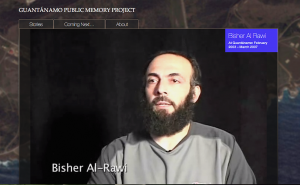Reflection: Gitmo and the Other
National Dialogue and Traveling Exhibit
Bisher al-Rawi’s story absolutely struck me most through the first days of this course. Al-Rawi, an Iraqi citizen who had been living in Great Britain, was detained by the United States for five years starting in 2002 without being charged with a crime, and for four of those years he was imprisoned at Gitmo. While we only get to hear him speak for a very short time in the video on the Guantánamo Public Memory Project website, it is jarring to hear a victim of imprisonment at Guantánamo Bay speak so frankly.
Oftentimes it appears that these prisoners are simply “the Other,” and to hear the human side of their suffering and their experiences has been powerful. It’s difficult to imagine gaining access to the story of someone like this through traditional news media, so the role of the Guantánamo Public Memory Project is immediately apparent. This speaks not only to the troubling role of the media in the modern world, but also to how perceptions could easily change if people are given the proper education and awareness. He does not seem to fit the traditional media stereotype of what a “terrorist” or “enemy combatant” should be, and instead speaks perfect, almost un-accented English as he calmly details his experiences.
Al-Rawi’s calmness also struck me. It is difficult to imagine myself remaining so calm in discussing a country that seized me without charges, and then imprisoned and tortured me for years. While certainly we cannot assume that all former detainees have the same level of forgiveness as al-Rawi, his interview could seem to serve as a counterargument to the ideas that it’s next to impossible to release someone from Gitmo due to fears of retaliation. In that sense, I think there are a number of questions that can be raised regarding his experiences. Namely, how does the media affect our overall knowledge of Guantánamo? Are we conditioned to fear in the name of “security”? Why are we not given the stories of detainees more often when discussing Gitmo? Is it possible to end the detainments at Guantánamo peaceably? All of these types of questions were going through my head as I listened to al-Rawi speak.
Posted by Jack Pittenger Public History Program, Arizona State University
Arizona State University is participating in the Guantánamo Public Memory Project‘s National Dialogue and Traveling Exhibit. Opening at NYU’s Kimmel Center for University Life Windows Gallery in December 2012 and traveling to 9 sites (and counting) across the country through at least 2014, the exhibit will explore GTMO’s history from US occupation in 1898 to today’s debates and visions for its future. The exhibit is being developed through a unique collaboration among a growing number of universities as a dialogue among their students, communities, and people with first-hand experience at GTMO.

